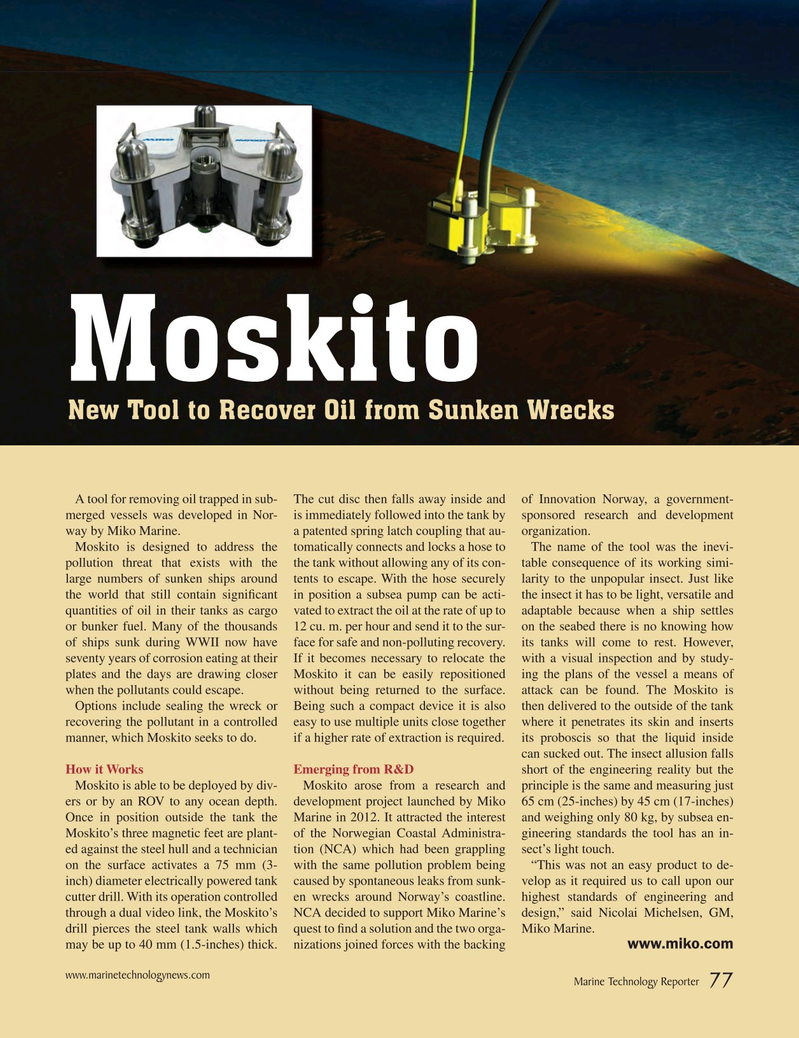
Page 77: of Marine Technology Magazine (March 2015)
Oceanographic Instrumentation: Measurement, Process & Analysis
Read this page in Pdf, Flash or Html5 edition of March 2015 Marine Technology Magazine
MoskitoMoskito
New Tool to Recover Oil from Sunken Wrecks
A tool for removing oil trapped in sub- The cut disc then falls away inside and of Innovation Norway, a government- merged vessels was developed in Nor- is immediately followed into the tank by sponsored research and development way by Miko Marine. a patented spring latch coupling that au- organization.
Moskito is designed to address the tomatically connects and locks a hose to The name of the tool was the inevi- pollution threat that exists with the the tank without allowing any of its con- table consequence of its working simi- large numbers of sunken ships around tents to escape. With the hose securely larity to the unpopular insect. Just like the world that still contain signi? cant in position a subsea pump can be acti- the insect it has to be light, versatile and quantities of oil in their tanks as cargo vated to extract the oil at the rate of up to adaptable because when a ship settles or bunker fuel. Many of the thousands 12 cu. m. per hour and send it to the sur- on the seabed there is no knowing how of ships sunk during WWII now have face for safe and non-polluting recovery. its tanks will come to rest. However, seventy years of corrosion eating at their If it becomes necessary to relocate the with a visual inspection and by study- plates and the days are drawing closer Moskito it can be easily repositioned ing the plans of the vessel a means of when the pollutants could escape. without being returned to the surface. attack can be found. The Moskito is
Options include sealing the wreck or Being such a compact device it is also then delivered to the outside of the tank recovering the pollutant in a controlled easy to use multiple units close together where it penetrates its skin and inserts manner, which Moskito seeks to do. if a higher rate of extraction is required. its proboscis so that the liquid inside can sucked out. The insect allusion falls
How it Works Emerging from R&D short of the engineering reality but the
Moskito is able to be deployed by div- Moskito arose from a research and principle is the same and measuring just ers or by an ROV to any ocean depth. development project launched by Miko 65 cm (25-inches) by 45 cm (17-inches)
Once in position outside the tank the Marine in 2012. It attracted the interest and weighing only 80 kg, by subsea en-
Moskito’s three magnetic feet are plant- of the Norwegian Coastal Administra- gineering standards the tool has an in- ed against the steel hull and a technician tion (NCA) which had been grappling sect’s light touch. on the surface activates a 75 mm (3- with the same pollution problem being “This was not an easy product to de- inch) diameter electrically powered tank caused by spontaneous leaks from sunk- velop as it required us to call upon our cutter drill. With its operation controlled en wrecks around Norway’s coastline. highest standards of engineering and through a dual video link, the Moskito’s NCA decided to support Miko Marine’s design,” said Nicolai Michelsen, GM, drill pierces the steel tank walls which quest to ? nd a solution and the two orga- Miko Marine. may be up to 40 mm (1.5-inches) thick. nizations joined forces with the backing www.miko.com www.marinetechnologynews.com
Marine Technology Reporter 77
MTR #2 (66-80).indd 77 MTR #2 (66-80).indd 77 3/8/2015 2:03:34 PM3/8/2015 2:03:34 PM

 76
76

 78
78
